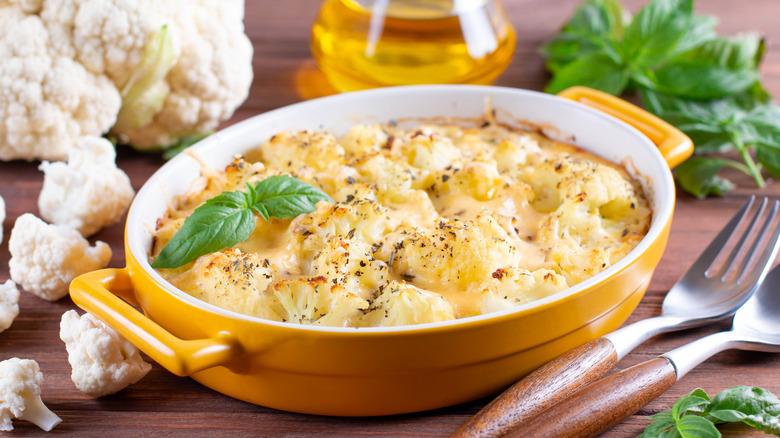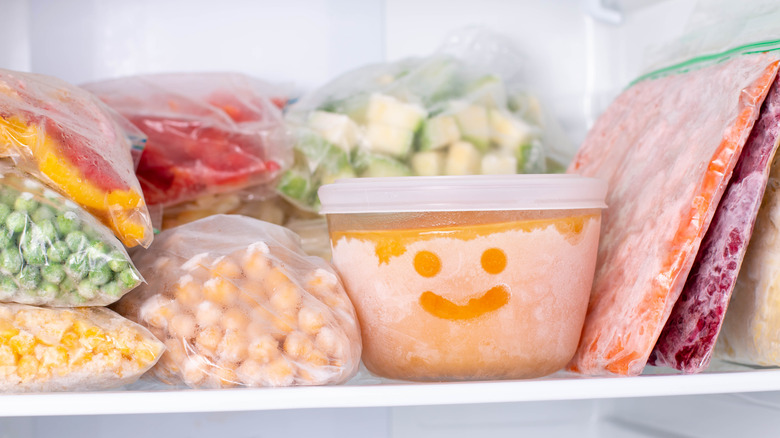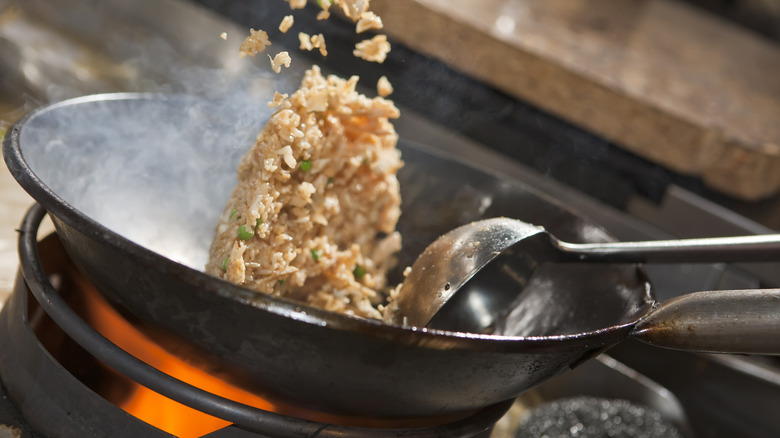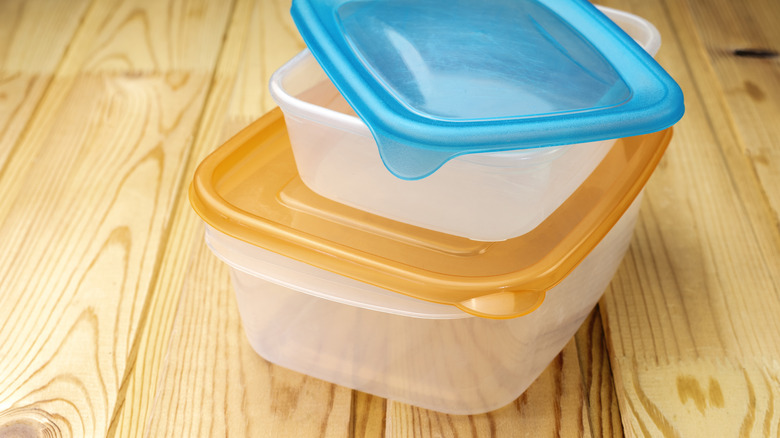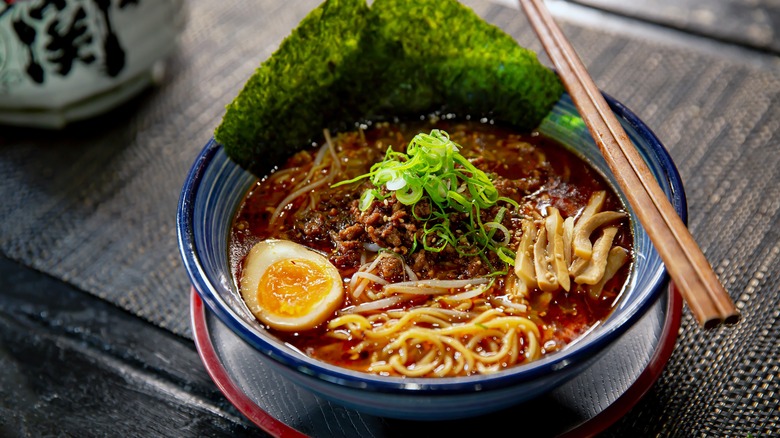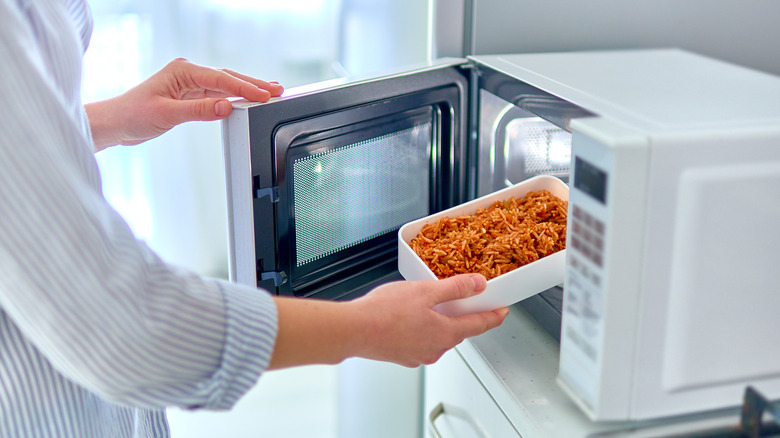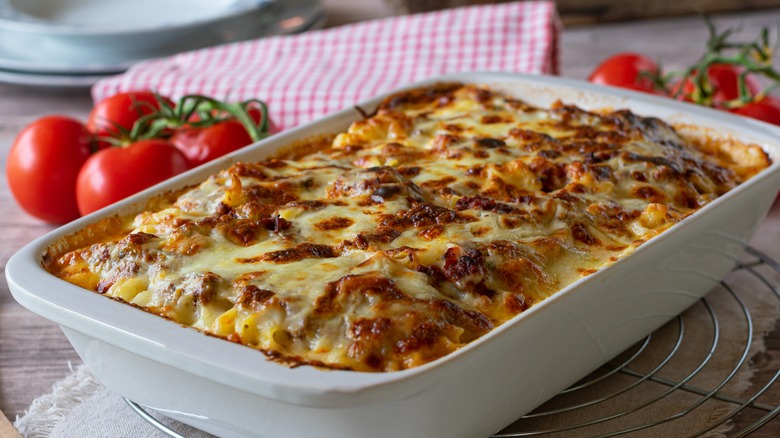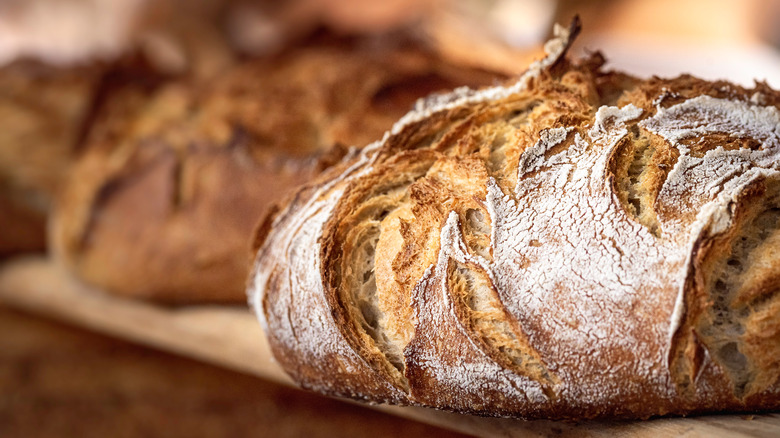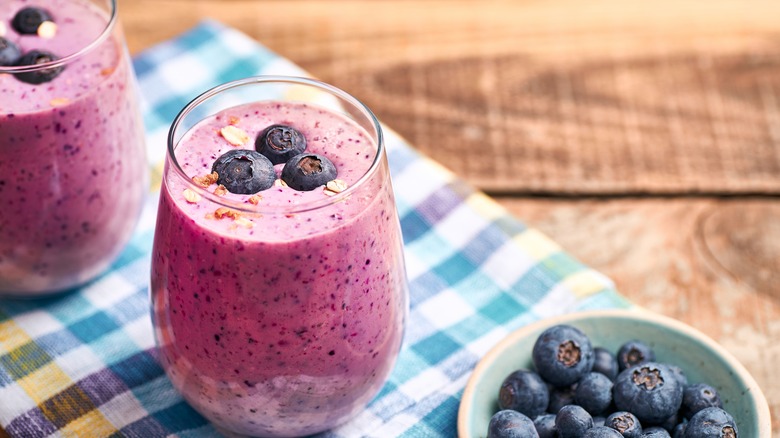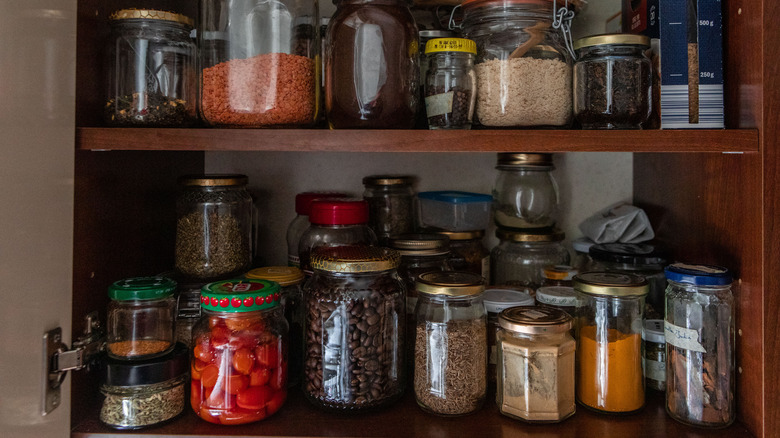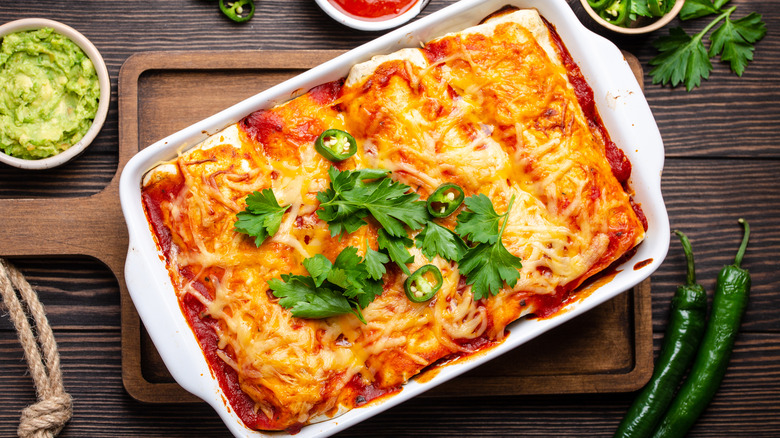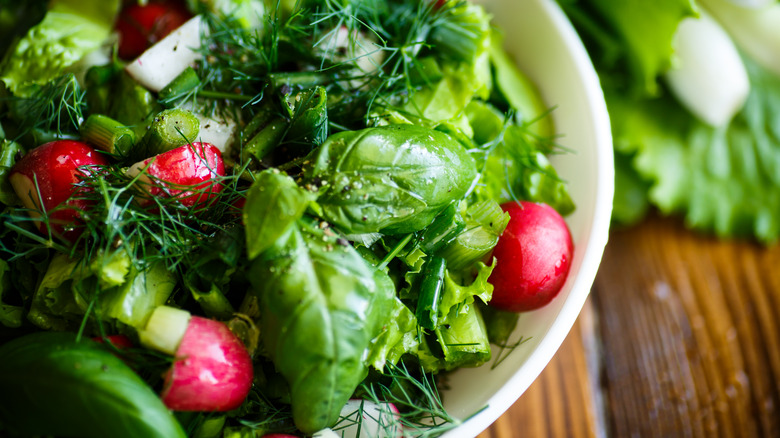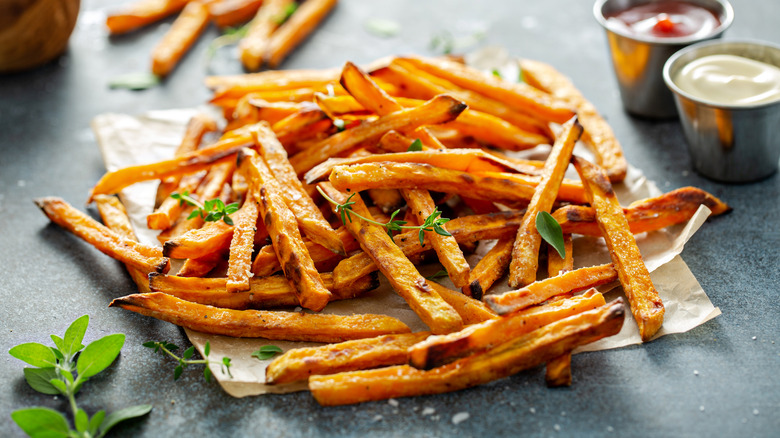Secrets That Will Bring Your Leftovers Back To Life
The USDA paints a grim picture: 30 to 40% of food is wasted every year in the United States. This is the food that never gets eaten — it just gets sent to landfills instead of feeding hungry families. Moreover, the whole process of producing, packaging, and disposing of food consumes a myriad of resources. And, per the European Environmental Bureau, Europe wastes more food than it imports — some 153 million tons every year. In an age where we still have wars and famine, it's quite pressing to discuss this and try to limit food waste. So why not start with our households?
A quick (and, let's be honest, tasty) way of reducing waste is by transforming leftovers into brand-new meals. Leftover food doesn't have to be boring, and it definitely doesn't have to be thrown away. If you follow these simple tricks, you'll be able to store, reheat, and revamp your fridge leftovers to perfection and forget about tasteless microwave food. And remember, you're doing the planet a favor, too! Without further ado, let's explore 13 secrets that will bring your leftovers back to life.
1. Freeze it for later
One of the quickest and most hassle-free ways to prolong your leftovers' life is to freeze them for later — that is, much later. But, as Work Week Lunch points out, make sure you freeze your food on the same day you made it — the longer you leave it in the fridge, the more you increase the chances of texture and flavor changes.
According to Tasting Table, there are several tricks when it comes to frozen food. First of all, make sure your food is properly stored in airtight containers so that you don't get freezer burn (those annoying ice crystals that take over your meal and turn it into an unpleasant soup when you heat it up). Then, be careful when you thaw your food — leave it in cold water or in the fridge, rather than put it in the microwave, or worse, leave it on the counter. Food relies on chemistry, and temperature changes affect its taste, texture, and various other factors. Freezing your leftover meal is a great way to save it for later and limit food waste, but read about the type of food you're freezing — depending on the ingredients, there are certain rules for thawing, cooking, or reheating it.
2. Change the flavor
If you're tired of having the same meal for two or three days in a row, the best thing you can do is completely transform it. If it's a salad, add new ingredients and make a fresh dressing to change its taste. If it's a side dish, add some fresh spices and serve it alongside something warm and fresh (and different from whatever you had the day before). But the options are truly endless when it comes to transforming protein.
We recommend the best fried rice recipe: It's quick, easy, and guaranteed to use up any ingredients you've got left in your fridge and pantry. This recipe uses barbeque pork, but it works perfectly with chicken, beef, and vegan protein as well (needless to say, fried rice is also a way to revamp leftover rice).
Stir fries also make great new meals from leftover protein — as Mashed suggests, all you really need is five-spice powder, soy sauce, oyster sauce, and the vegetables and rice that you might already have at home. As per Tasting Table, you can also transform your leftover protein into fresh skewers with tropical undertones, such as pork and pineapple skewers. Generally speaking, feel free to go crazy with flavors you like — you'll turn boring fridge leftovers into a brand-new meal and you might even forget you're eating leftover food.
3. Store it properly
This next trick is not so much about bringing leftovers back to life but making sure they stay "alive" once you've cooked them. Say you've prepared a perfect meal and you want to serve it again tonight, or the next day. Don't just throw it in the fridge uncovered — it'll dry up within hours. According to Work Week Lunch, simply covering your meal with foil or saran wrap isn't enough, as they're not airtight. This means that the food will still dry up and, on top of it, its smell will seep out into the rest of the fridge.
The simple solution is storing your leftover meals in airtight containers with snap lids. These will protect the food for much longer than any other dish and cover combination. Also, make sure you refrigerate your food as soon as it's cooled down — the longer you leave it out at room temperature, the more likely it is for nasty bacteria to develop. It's also worth noting that leftover food can be safely stored in the fridge for three to four days, according to the Mayo Clinic. In some cases, you can store it for longer, but the risk of food poisoning increases with every extra day. So if you've made a ton of food, better freeze it in those airtight containers.
4. Add moisture
One of the main problems with leftover food is that it dries out in the fridge — even stored perfectly, it's simply not the same as it was fresh out of the oven. The answer to this age-old conundrum is revamping that dry dish into a juicy meal, such as soup, curry, or enchiladas. Pho and pad Thai ramen can take leftover protein to the next level. Meat is the most likely to dry and lose its je ne sais quoi in the fridge, so simply cut it into thin slices and add it to these delicious soups. The recipes are also quite versatile, so you can add whatever flavors you like best to the broth.
Then, there's the case where you don't want to transform your leftover meal into something new. No problem — just add a bit of water, milk, or cream to it before reheating it, as Insider suggests. This works particularly well with grains (such as rice or pasta) and vegetables. They absorb moisture when they're stored in the fridge, so they're in dire need of a little moisture before they go back in the oven. When it comes to meat, add a little grease (butter or olive oil) to make it juicy and flavorful again.
5. Avoid the microwave
Microwaves were a miraculous and life-changing invention when they first started decorating home kitchens, but today, we're aware of the many issues they can cause. For starters, they tend to make leftover meals soggy and tasteless. If you're unlucky, they can also heat food unevenly — you burn yourself with one bite, then wonder why the next is completely cold. Then, as The Healthy reports, there are foods that can become toxic when reheated in a microwave. Microwaved hard-boiled eggs can become tiny steam bombs, the chemicals in processed meats become even worse when microwaved, and leafy greens can even become carcinogenic.
So, if you have the option, reheat your leftover meals in the oven or on the stove. This way, they will retain their original flavor and keep the crispy texture. And if you do end up reheating your meal in the microwave, Work Week Lunch suggests partially covering it with a lid, so that the steam brings back the flavor. If there's a mushiness risk, heat the food on a plate lined with a paper towel so that it absorbs the extra moisture, and if there's an uneven heat risk, stir your meal halfway.
6. Make a casserole
There's absolutely nothing wrong with all the food you like brought together in a dish, topped with cheese, and thrown into the oven. When it comes to leftovers, casseroles are practical, too: You're using several ingredients and bringing them back to life, instead of letting them waste away on their own. And, you're making a casserole out of already cooked food, so it doesn't have to sit in the oven for upwards of an hour.
As we're previously shown, casseroles are extremely versatile dishes that work for any occasion or time of day. You can make a simple vegetable or broccoli casserole (using cream of mushroom soup and plenty of cheese) or you can get creative with sloppy joe biscuit and king ranch chicken casseroles. In fact, there are several breakfast casserole recipes too, including eggs benedict and French toast casserole. If we've said "casserole" too many times, just know there is one version for any type of leftover in your fridge, and it's guaranteed to transform it into nice, warm comfort food.
7. Revamp stable carbs
Few things sound more unappetizing than stale carbs, but they really can be turned into something good. You can easily resurrect stale bread by wrapping it in a damp paper towel and microwaving it for 20 seconds. But this trick only works if you're planning on serving the bread right afterward — otherwise, it will get even drier than before.
However, the list is very long when it comes to repurposing stale bread. It can be made into breadcrumbs, bread pudding, or any kind of loaf. Crumbs can be made from stale chips, too, and these can be used to sprinkle on top of meats and even desserts (brownies and chocolate chip cookies included). Stale cookies can also be crumbed and used to decorate ice cream. But we've got another idea regarding breadcrumbs: this classic beef meatloaf, filled with onion, garlic, thyme, and all your favorite spices. It's very easy to make and will take that stale bread to a whole new (and much juicier) level.
8. Turn your leftover fruit into smoothies
As Insider explains, leaving sliced or halved fruit in the fridge is the beginning of the end for their texture, taste, and moisture. Leaving fruit at room temperature doesn't help, either – as soon as air gets in, they lose their quality. One quick solution is to chop up your fruits and turn them into a smoothie. Whether fresh or frozen, fruit can be easily combined to create the perfect smoothie (and you can add milk, vegan milk, or yogurt, for a more adventurous approach).
Smoothies don't have to be boring, either. You can make a perfectly delicious smoothie by following a simple recipe comprising fruit, liquid, thickener (like chia seeds, peanut butter, or avocado), and any add-ins (or superfoods) you prefer. Smoothies are also quite versatile and work in various combinations, which means you can get rid of multiple fruits and vegetables lying around in your fridge. Sweet potatoes and carrots can be merged with bananas, dates, and almond milk to create the perfect pie-like smoothie. And if you've got berries and Greek yogurt on hand, you can mix them up with beets, orange juice, almond milk, and ginger for a healthy and flavorful smoothie.
9. Versatile rice
Indeed, few foods are as versatile as rice, and cooked rice is no exception. Tasting Table shares 21 ways to revamp your leftover rice, and chances are there are even more options if you're feeling creative. This is because rice is used in cuisines all over the globe. It's a simple grain that soaks up any sauce, spice, and flavor, so it's easy to transform into a new meal.
On the one hand, you can simply reheat rice and use it as a base for a brand-new dish, such as a curry. You can also use it to fill a burrito or a hearty soup. And if you're up for some extra work, you can use it to make stuffed peppers, zucchini, or squash.
On the other hand, you can also cook a brand-new dish with already-cooked rice. Fried rice, creamy risottos, and rice frittatas make perfect dinner options, but you can take it even further and go for dessert. Simple white leftover rice can be turned into sweet rice pudding or rice cakes. As long as you've got cream, sugar, and cinnamon, you can't really go wrong.
10. Add spice
There are a million leftover recipes out there waiting to be explored and even reinvented. But understandably, you may not want to turn your leftover meal into something entirely different. However, if you coat it with a fresh mixture of spices and/or sauces, it'll feel new enough. This works best if you plan it from the get-go. This means that you shouldn't over-season your original meal, or season it with a flavor so strong that it will overpower anything you bring to it the next day.
So if you've got a bit of protein, grain, or vegetable that's a bit dry and a bit bland, sprinkle it with some extra seasoning and heat it up. You can completely transform fried chicken breast, for example, if you coat it with curry powder, re-fry it, and serve it with freshly steamed rice. There's yet another option: When you cook your initial meal, you can leave a portion of it completely unseasoned — just store it in an airtight container and it's a perfect base for whatever you want to revamp it into the following day.
11. Make it into a cheesy dish
Be it loaded nachos, enchiladas, casseroles, or any sort of macaroni and cheese, melting cheese onto leftovers will definitely make them warm, juicy, and very pleasurable to eat. Take this recipe for easy chicken enchiladas, for example. You can easily swap the chicken for any leftover meat you have. Shred it up and stuff it into tortilla wraps along with sour cream, tomatoes, and whatever else you like. Cover them in enchilada sauce, top it all with a crazy amount of cheese, then leave it in the oven until the cheese melts and you get the perfect cold season comfort food.
As per BBC Good Food, there is a myriad of leftover cheese recipes — cheese is full of flavor and creates an amazing texture when it melts, so it's easy to see how it can bring a leftover meal back to life. And, as Jamie Oliver shows, leftover cheese can also be revamped into fresh meals, such as baked Camembert, three-cheese risotto, or Christmas quiche.
12. Revamp your greens
Here's a quick tip: Even leafy greens can be brought back to life if you dip them in super-cold water for a few minutes (via Bon Appétit). Five minutes should do, and you have crispier, fresher-looking leaves that can make the perfect leftover salad. Of course, this is if you haven't already drenched your leafy greens in oil, balsamic vinegar, and other dressings. But rest assured, there are solutions for that, too. If the salad already has dressing on it, revamp it by adding lemon and salt — it won't change the flavor, it will just bring the original flavor (and salad) back to life.
Be careful, though: As Tasting Table reports, salad greens offer a growing environment for bacteria such as listeria and E. coli. The rules are simple enough: If it smells bad, looks brown, wilted, or slimy, throw it away. In the end, food waste is not as bad as food poisoning. Speaking of leafy greens, spinach can also become toxic when reheated. So better spray it with some fresh dressing and eat it cold.
13. Reheat french fries in the oven or skillet
There's nothing quite as disappointing as microwaved french fries. Mashed explains why: Microwaves heat food from the inside out, and fries are notorious for being crispy on the outside. So, to reheat your fries in the microwave and retain their texture would mean burning them to a crisp. Microwaves also have the nasty habit of heating food unevenly, and with fries, this can go very wrong — you'll have overcooked fries paired with soggy ones on the same plate.
Luckily, there are solutions: French fries can be easily re-fried in a skillet large enough to contain them in a thin layer. However, you don't need a lot of oil (do not re-deep fry fries, they might become too oily). A less messy option is heating your fries in the oven at 450 degrees Fahrenheit. Just make sure that the oven, as well as the tray, are preheated when you put in the fries, that way, they will keep their great texture. Sprinkle some extra salt on them and voilá!
